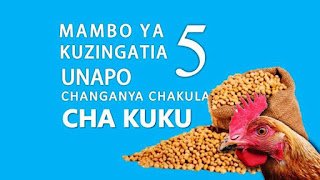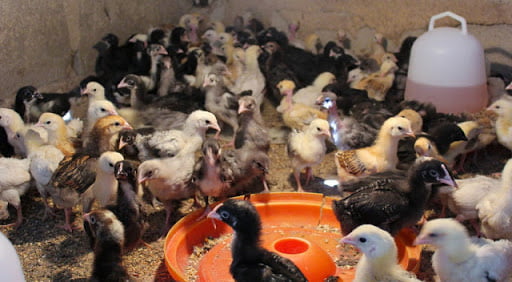CHICKEN NUTRITION :
In order for chickens to survive, grow well, gain weight and lay many eggs, they must eat a lot of food of the required quality. The quantity and quality of chicken nutrition can be classified into food groups as follows:
1. Energizing foods
2. Bodybuilding foods
3. Foods to strengthen bones
4. Foods to protect the body
5. Water.
Food groups:
- Energizing foods:
The following livestock feeds are included in this group; a. Maize bran, fine rice bran, and fine wheat bran. b. Grains such as millet, maize bran, rice bran, sorghum, and millet. Root crops such as cassava, sweet potatoes, and yams. Before feeding chickens, make sure the roots are soaked for an hour or cooked before drying to remove the toxins that are naturally present in these foods. It is recommended that the roots be fed at a rate of 10% of the total feed given to chickens. In this energy-boosting group, fatty foods such as oils from fatty foods such as vegetable oils, fish oil help increase energy and body temperature. Energy-boosting foods contribute 60-70 percent of the total feed mix.
1. Bodybuilding foods:
Ø Sunflower Cake: These are the husks of legume seeds and foods that provide oil such as sunflower, palm, peanut, soybean, cashew, and sesame.
Ø Dried animal blood (slaughtered and inspected), this is done to avoid the possibility of chickens getting infectious diseases.
Ø Fish waste from fish/seafood and meat.
Ø Natural foods such as worms, termite eggs, meat scraps from skin/bones, insects killed from blood or rotten meat and other types of foods.
Ø These foods contribute 20 to 30% of the total chicken feed mixture.
2. Bone-strengthening foods (minerals):
a) These are mineral foods that are needed for building bones, eggshells, growing and keeping the body of the bird (chicken) in good health in general.
b) The most important minerals are calcium and phosphorus. In order for chickens to lay hard-shelled eggs, they must get calcium from snail shells and well-ground eggs. But it is recommended that when adding phosphorus, you must also add lime as needed, because if the amount of one type exceeds the other, it causes a deficiency of the smaller one. The required mineral supplements include;
Ø Finely ground bone ash, ground sea snail shell powder, land snails and roasted egg shells. Before egg shells and snail shells are used, it is recommended that they be heated or boiled to kill disease-causing germs.
Ø Kitchen salt
Ø Industrially produced minerals such as Di-calcium phosphate .
4. Foods to protect the body
:This group includes vegetable foods such as; Ø Spinach, cow dung that has not been left for a long time after being soaked, wild spinach, Chinese cabbage etc. Ø and Vitamin mixtures made by pharmaceutical companies (vitamin premix). Ø Sunlight is important in ensuring that vitamins A and D are used properly in the body, so the shed must be built in a way that allows light to pass through, especially in the morning and evening. Ø The food of chickens raised indoors must be mixed with vitamins that are prepared in factories.
MIXING CHICKEN FOOD :
Methods of mixing chicken feed; There are two main methods of mixing chicken feed, which are;
Ø Mixing food with a machine ;
This method is used in factories to mix feed for chickens raised on large farms.
Ø Mixing food at home (home made ration):
This is a method used to mix feed for feeding a small flock of chickens and a method that can be used by small-scale farmers.
EQUIPMENT;
Spade, Clean tarp/floor, Ladles, Cloths/Sacks for storing mixed food.
Mixed feed can be packaged in 25-50 kg, or 100 kg packages.
ANALYSIS OF POULTRY FEED INGREDIENTS :
Type of food in moderation i. Foods to strengthen the body: Ø Maize bran 48 kg Ø Soft rice bran 26 kg
Total 74 kg
ii. Bodybuilding foods:
18 kg sunflower seeds
Animal blood 1 kg Fish/seafood waste 3 kg
Total 22 kg
iii. Foods to strengthen bones (Minerals):
- ½ kg kitchen salt
- Lime (dicalcium phosphate)… 2 kg
- poultry premix/ kilo ½
- 1 kg bone meal
Total 4 kg Ø Actual nutritional requirements in summary:
Ø Foods to strengthen the body 74 kg Ø Foods to build body 22 kg Ø Foods to strengthen bones (Minerals) 4 kg
TOTAL 100
Total food mix 100 kg
STEPS TO MIX CHICKEN FOOD :
STEP ONE:
In the first step you will start mixing the mineral food, lime, salt and bone ash pig mix well – this will be called mixture No. 1
STEP TWO:
Mix the mixture with the blood and the minced fish – this will be called mixture No. 2.
STEP THREE:
Mix mixture No. 2 with the mashudo well which you will call mixture No. 3.
STEP FOUR:
Pour mixture No. 3 over the mixed bran pile (maize bran and fine rice bran). o Take a clean, dry shovel/spoon and use it to mix the feed pile to distribute the nutrients well.
Things to consider in feeding and storing chicken feed:
a) After mixing the feed, it will be placed in bags or sacks and stored in a barn (stove) until it is needed for feeding the chickens. b) Make sure the chickens are getting the nutrition recommended by experts. c) The mixed feed must be kept in a dry place so that it is not damaged by moisture, such as in a well-arranged feeder with chips spread on stones. d) Spoiled food is not suitable for feeding chickens as it can cause health problems. d) The mixed feed should not be left for a long time after preparation.
Supplementary feeds: To ensure that chickens get enough nutrients, chickens can be given ants and mealworms. Also, the types of grain alternatives available depend greatly on the types of crops grown in the area.
Methods for raising ants and maggots :
Maggots and ants are good and easy sources of protein for free-range chickens. However, these protein sources only contribute to the amount of protein that chickens need.
a). It is advisable to feed the chicks worms and ants because they need a large and reliable amount of protein.
b) Maggots and larvae can be easily raised and used to improve chick feed.
c) Maggots and larvae can be grown using blood, cow’s internal organs, and cow dung.
d) Fill the pot one-third full with water. Flies will come and lay eggs in the mixture, which the infected larvae will then start eating.
e) After that all these things will be mixed together in one large pot which will be left open during the day and covered at night.
f) After five days, water will be filled in the jar and the fry will be collected while they are floating on the surface. After collecting them, wash them well with water and then feed them directly to the chickens.
g) Remember to keep the pot where the plants are grown away from crowded areas to avoid odors that may bother people.
FEEDING CHICKEN : Estimated food intake for feeding 100 chicks/day:
| Age (weeks after birth) | Number of chicks | Required amount per day (kg) |
| 1 | 100 | 1 |
| 2 | 100 | 1 |
| 3 | 100 | 2 |
| 4 | 100 | 3 |
| 5 | 100 | 4 |
| 6 | 100 | 5 |
Brief information on feeding chickens:
It is difficult to estimate the food requirements of free-ranging chickens, but it is estimated that a large chicken weighing 1-2 kg needs 80-160 grams of food per day for chickens kept indoors, but for chickens kept in a semi-free range system, the requirements are estimated to be reduced to 30-50 grams per day. It should also be noted that the amount of food depends on the needs due to weight and production, for example, laying and growing chickens need more food than those that are not laying or have stopped growing. Make sure that the chickens are provided with clean food and water in clean containers and change them whenever they run out………………………………………………………………………………………………………………………………………………





